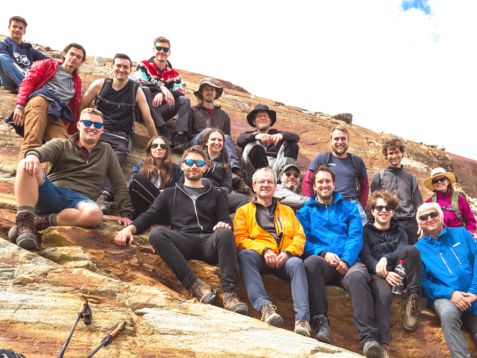MLZ is a cooperation between:
 > Technische Universität München
> Technische Universität München > Helmholtz-Zentrum Hereon
> Helmholtz-Zentrum Hereon
 > Forschungszentrum Jülich
> Forschungszentrum Jülich
MLZ is a member of:
 > LENS
> LENS > ERF-AISBL
> ERF-AISBL
MLZ on social media:

MLZ (eng)
Lichtenbergstr.1
85748 Garching
23.08.2022
Scientific Exchange on Positrons and Antimatter

From left to right, back: Dylan Schmeling, Maksym Melnyk, Matthias Dodenhöft, Michael Zimmermann, Vassily Burwitz, Johannes Mitteneder, Lucian Mathes, Adrian Langrehr, Ulrike Zweck; middle: Lisa-Marie Krug, Vicky Chen, Ricardo Helm; front: Johannes Lehtonen, Marcel Dickmann, Christoph Hugenschmidt, Markus Singer, Carl Rogge, Sebastian Vohburger. © Markus Singer, IPP
From 05 – 08 July, the retreat “Antimatter: Positrons in Fundamental Research and Materials Physics” took place at the Dresdner Hütte in the Stubaital. At the event, which was sponsored by the Heraeus Foundation, MLZ researchers exchanged ideas with other experts in positron research and inspired the younger generation about their field of research.
The working group “Physics with Positrons” at the Heinz Maier-Leibnitz Zentrum (MLZ), headed by Prof. Christoph Hugenschmidt, held its retreat in a spectacular mountain setting at an altitude of 2308m. The 18 participants from a total of three different working groups from the Technical University of Munich (TUM), the Universität der Bundeswehr München (UniBWM) and the Max Planck Institute for Plasma Physics (IPP) gave diverse presentations on the importance of positrons in fundamental research and material physics.
Future development of positron research
Lively discussions led to many new ideas and impulses, which promoted the professional exchange between the scientists. The participants followed the plans for future measurements and instrumental upgrades at the world’s most powerful positron source NEPOMUC at the Heinz Maier-Leibnitz Zentrum (MLZ) in Garching with great interest. A particular upgrade includes the future expansion of the instrumentation in the Neutron Guide Hall East.
Focus on personal contacts
In addition to the scientific topics, getting to know each other was not neglected: glacier excursions, hikes and joint dinners offered many opportunities to make new contacts. “After more than two years of mainly virtual conferences, this year’s retreat was a very profitable gathering, both professionally and personally,” summarizes Prof. Hugenschmidt. Especially the younger working students gained deeper insights into positron research and scientific practice in general.
Heraeus Foundation promotes scientific exchange
The organizers of the retreat received financial support from the Wilhelm and Else Heraeus Foundation. This foundation promotes events that serve scientific exchange and enable young researchers in particular to take their first steps into science.
Further information:
Representatives of the following working groups participated in the retreat,“Antimatter: Positrons in Fundamental Research and Materials Physics“: Group Physics with Positrons at the Technical University of Munich (TUM), the Positron Group at LRT2 at the Universität der Bundeswehr München (UniBWM), and the Electron-Positron-Plasma Group at the Max Planck Institute for Plasma Physics (IPP).
MLZ is a cooperation between:
 > Technische Universität München
> Technische Universität München > Helmholtz-Zentrum Hereon
> Helmholtz-Zentrum Hereon
 > Forschungszentrum Jülich
> Forschungszentrum Jülich
MLZ is a member of:
 > LENS
> LENS > ERF-AISBL
> ERF-AISBL
MLZ on social media:


